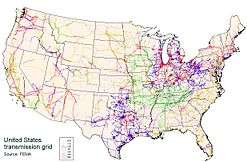Droop speed control
In electrical power generation, droop speed control is a speed control mode of a prime mover driving a synchronous generator connected to an electrical grid. This mode allows synchronous generators to run in parallel, so that loads are shared among generators in proportion to their power rating.
The frequency of a synchronous generator is given by
where
- F, frequency (in Hz),
- P, number of poles,
- N, speed of generator (in RPM)
The frequency (F) of a synchronous generator is directly proportional to its speed (N). When multiple synchronous generators are connected in parallel to electrical grid, the frequency is fixed by the grid, since individual power output of each generator will be small compared to the load on a large grid. Synchronous generators connected to the grid run at various speeds but they all run at the same frequency because they differ in the number of poles (P).
A speed reference as percentage of actual speed is set in this mode. As the generator is loaded from no load to base load, the actual speed of the prime mover tend to decrease. In order to increase the power output in this mode, the prime mover speed reference is increased. Because the actual prime mover speed is fixed by the grid, this difference in speed reference and actual speed of the prime mover is used to increase the flow of working fluid (fuel, steam, etc.) to the prime mover, and hence power output is increased. The reverse will be true for decreasing power output. The prime mover speed reference is always greater than actual speed of the prime mover. The actual speed of the prime mover is allowed to "droop" or decrease with respect to the reference, and so the name.
For example, if the turbine is rated at 3000 rpm, and the machine speed reduces from 3000 rpm to 2880 rpm when it is loaded from no load to base load, then the droop % is given by
- =(3000 – 3120) / 3000
- = 4%
- = (3000 – 2880) / 3000
- = 4%
In this case, speed reference will be 104% and actual speed will be 100%. For every 1% change in the turbine speed reference, the power output of the turbine will change by 25% of rated for a unit with a 4% droop setting.
Droop is therefore expressed as the percentage change in (design) speed required for 100% governor action.
For example, how fuel flow is increased or decreased in a GE-design heavy duty gas turbine can be given by the formula,
- FSRN = FSKRN2 × (TNR − TNH) + FSKRN1
where,
- FSRN, fuel stroke reference (fuel supplied to gas turbine) for droop mode
- TNR, turbine speed reference
- TNH, actual turbine speed
- FSKRN2, constant
- FSKRN1, constant
As frequency is fixed on the grid, and so actual turbine speed is also fixed, the increase in turbine speed reference will increase the error between reference and actual speed. As the difference increases, fuel flow is increased to increase power output, and vice versa. This type of control is referred to as "straight proportional" control. If the entire grid tends to be overloaded, the grid frequency and hence actual speed of generator will decrease. All units will see an increase in the speed error, and so increase fuel flow to their prime movers and power output. In this way droop speed control mode also helps to hold a stable grid frequency. The amount of power produced is strictly proportional to the error between the actual turbine speed and speed reference. The above formula is nothing but the equation of a straight line (y = mx + q).
It can be mathematically shown that if all machines synchronized to a system have the same droop speed control, they will share load proportionate to the machine ratings.[1]
For stable operation of the electrical grid of North America, power plants typically operate with a four or five percent speed droop.[2] With 5% droop the full-load speed is 100% and the no-load speed is 105%. This is required for the stable operation of the net without hunting and dropouts of power plants. Normally the changes in speed are minor due to inertia of the total rotating mass of all generators and motors running in the net.[3] Adjustments in power output are made by slowly raising the droop curve by increasing the spring pressure on a centrifugal governor or by an engine control unit adjustment. Generally this is a basic system requirement for all power plants because the older and newer plants have to be compatible in response to the instantaneous changes in frequency without depending on outside communication. Voltage control of several power sources is not practical because there would not be any independent feedback, resulting in the total load being put on one power plant.[4]

The thousands of AC generators are running synchronously with the power grid which acts like an infinite sink. Next to the inertia given by the parallel operation of synchronous generators,[5] the frequency speed droop is the primary instantaneous parameter in control of an individual power plant's power output (kW).[6]
S is the ratio of frequency deviation when comparing the load versus the nominal frequency.
Notes
- ↑ William D. Stevenson, Jr. Elements of Power System Analysis Third Edition,McGraw-Hill, New York (1975) ISBN 0-07-061285-4 page 378-379
- ↑ "Governor Control". Control.com. Retrieved 2015-12-24.
- ↑ "Real Time Frequency Data - Last 60 Minutes". National Grid. Retrieved 2015-12-24.
- ↑ Speed Droop and Power Generation. Application Note 01302. 2. Woodward. Speed
- ↑ VSYNC-Project
- ↑ Whitaker, Jerry C. (2006). AC power systems handbook. Boca Raton, FL: Taylor and Francis. p. 35. ISBN 978-0-8493-4034-5.
See also
Further reading
- Alfred Engler: Applicability of droops in low voltage grids. International Journal of Distributed Energy Resources, Vol 1, No 1, 2005.